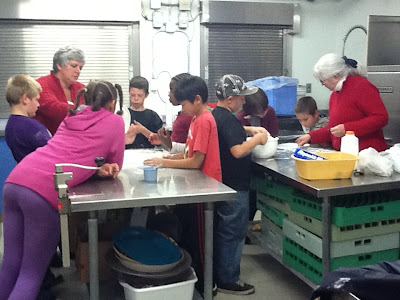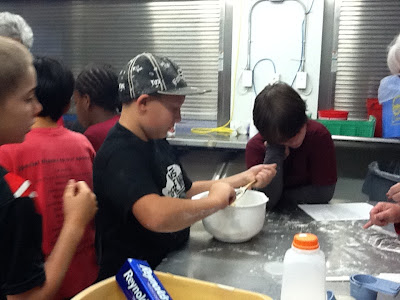It was writing time and I was chopping onions with three students, one eye on the clock. In twenty minutes the sixth graders had to leave for their math class and fifth graders from another room would be coming in to have math class with me.
Everyone (except the onion choppers) had writing work in front of them, but their pencils were moving at varying speeds, if you know what I mean. Writing is hard work, and if you're not in the mood, or not sure what to say, it can become near impossible. Which is why normally, I'd be circulating around the room encouraging, wheedling, and threatening. Instead I was standing in front of two pots of melting butter, watching tears stream down the cheeks of three tough boys and answering writing questions from a distance. I felt like a cheerleader on the sidelines.
We were making corn chowder. Corn has been an important part of the standard U.S. diet since long before there was a U.S. Previously we had discussed how all of the ingredients, save the spices, were items New Englanders have been able to grow or harvest for hundreds of years.
Almost everyone got to come and help with one step or another, the ingredients all made it into the pot in time, and one enterprising fifth grader helped me with the dishes as others cleaned up their writing (Thanks D! You can come clean up at my house anytime.) The chowder simmered through math, lunch and recess. Later in the afternoon kids got to try as much or as little as they wanted. Many opted for a small serving in a cup and then came back for seconds. Several started out with a bowl full and then polished off another. Only a few tried it and decided it wasn't for them. One boy did inform me that his father's corn chowder was better, but he said it kindly, as if he were concerned for my feelings.
Thoughts on this food excursion:
-I like working with my students in small groups when we're cooking, but
-doing so means no one (but me) gets to experience the whole recipe start to finish.
-I am still trying to figure out “the best” was to incorporate the cooking part. Managing a whole group while cooking is tricky, but otherwise the cooking can distract from whatever else everyone else is doing in the room.
-Kids are trying new and healthy foods. I am jazzed about this. Even if they don't love what they're trying, they're trying it. And many do truly like what they're trying.
-At the beginning of the year I wish I'd surveyed everyone about what kinds of foods they like, how healthy they eat or think they eat, etc. Then I could track a change in attitudes and habits. I am still mulling over how to best incorporate this into the process mid year. I am especially interested in what healthy and/or adventurous eating is spilling over at home.
- I need to build time into the class schedule in advance of cooking to make them double or triple the recipes. Why pass up the opportunity for a real life application of math skills?
-Eating is social. As I watched students hang out and joke around while they ate their chowder, I wondered if socializing was overpowering the experience of trying something new and absorbing the significance of the foods we were eating. But it is natural to combine eating with being together as a group; I can't imagine making everyone sit at their assigned seats and eating their chowder silently. Instead I wonder how I can structure the eating of what we've prepared so that learning stays at the forefront but the natural inclination to socialize is honored.






















